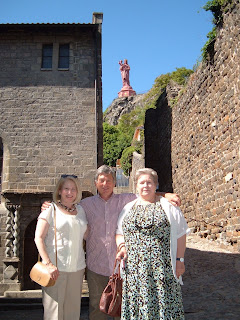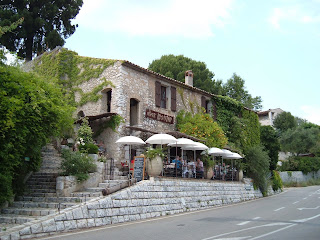
When planning this trip we decided not to take the auto-route but instead drive straight west on small country roads over the Monts du Cantal. The largest of the extinct volcanos are found in this area and are the most magnificent in the Auvergne. We came upon a charming town called Vic-sur-Cère; a former spa town with picturesque houses organized around the Eglise St.Pierre. We stopped to buy some famous Cantal cheese and noticed a week-end gathering of participants from various communities celebrating local traditions. We continued on to the Dordogne and Périgord; a region of small medieval villages, rolling hills and prehistoric sites. This is a gourmet's paradise...famous products include goose and duck liver paté (fois gras), confit de canard, Cabécou goat cheese, truffles, walnuts, dried sausage, and a sweet liquor called Bergerac. Sarlat, our home base for the week-end, is a beautiful medieval town renowned for its golden-stone buildings. All around the area are caves and caverns and, above all, pre-historic art from 17,000 years ago. Our first and most important stop was to see Lascaux II. The caves (Lascaux) were discovered in 1940 when a boy's dog fell down a hole. When the children entered to get the dog out they discovered cave engravings and paintings. After the caves were opened to the public it took only 15 years for the paintings to become damaged by white and green mold. The caves were closed to the public and a facsilimi was built 300 yards away using techniques that were used 17,000 years ago. It was fantastic to see Lascaux II and to imagine real art produced when mammoths and saber-toothed cats still roamed the earth.
 |
| Lascaux II (poster) |
|
|
|
Roger and I were interested in finding a goose/duck farm to watch what is called "la gavage". This is the force feeding of ducks and geese resulting in quickly fattening their livers in order to make the regional specialty, fois gras. It was very interesting to visit Elevage du Bouyssou, a short drive from Sarlat, where we had a tour of the farm and watched the "gavage". We learned that every part of the duck is used (except heads and feet) and even the feathers are sold for pillows. Also, the animals are in no pain as they are able to take in large amounts of food and have no gag reflex. They have massive gullets and expandable livers used to store fat for long migrations. The birds live in a free-range environment until the last 3-4 weeks of their lives.
 |
| Elevage du Bouyssou |
 |
| Tour with Natalie at her farm |
 |
| Natalie's husband, Denis..."la gavage" |
 |
| Tasting afterwards of Fois Gras and Bergerac |






























